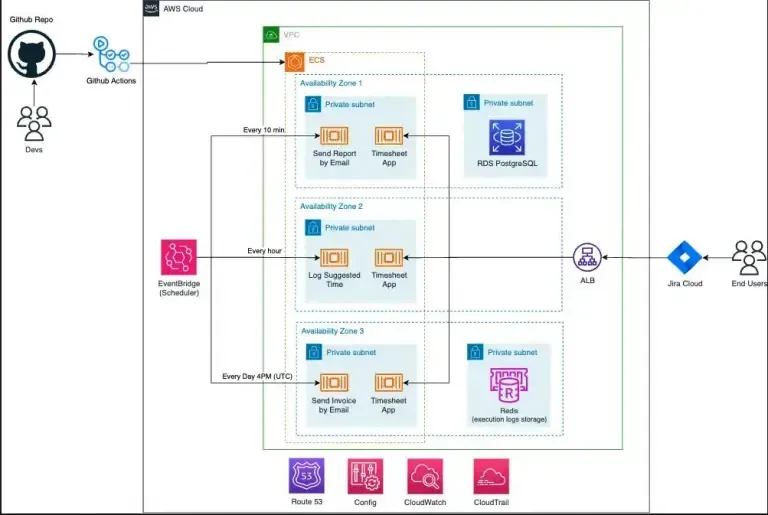Tempo Software triples application process capacity after AWS migration by e-Core
Learn how e-Core built a scalable, secure, and observable solution for Tempo's migration from Heroku to AWS
Tempo Software is a Boston-based leading provider of time-tracking, resource-planning, and project management solutions. As a key player in the Atlassian ecosystem, Tempo serves over 30,000 clients in more than 100 countries. Their solutions help businesses worldwide orchestrate the creation and delivery of work, allowing teams to focus and optimize around their highest priorities.
Tempo needed to address a critical issue with the hosting infrastructure for Timesheets, an entry-level Jira time-tracking solution focused on small businesses that is essential to their strategy. Acquired in 2020 and originally called Prime Timesheet, the application was hosted on Heroku, which was incompatible with the rest of Tempo’s infrastructure on Amazon Web Services (AWS).
Join us to discover how e-Core engineered a scalable, secure, and observable migration from Heroku to AWS for Tempo!
The challenge
The imminent departure of one of the product’s creators prompted the company to migrate Timesheets to AWS to ensure greater reliability and scalability. With over 20,000 instances in use worldwide daily, it was important to avoid service disruption during the migration, as many businesses relied on the product for their operations. Tempo chose e-Core to create a comprehensive migration plan to AWS.
Our Work
- Developed a migration plan from Heroku to AWS
- Leveraged Terraform for infrastructure as code (IaC) to efficiently provision and manage AWS resources.
- Established continuous integration and deployment (CI/CD) pipelines using GitHub Actions
- Created a new Virtual Private Cloud (VPC) to isolate and secure Tempo’s infrastructure
Containerized the application with AWS Elastic Container Service (ECS) for efficient management and scalability - Integrated AWS CloudWatch to enhance observability
- Managed sensitive information securely using AWS Secret Manager
- Migrated the database to AWS Relational Database Service (RDS) for enhanced scalability, reliability, and automated backups
Results
- 100% increase in scalability, allowing dynamic resource adjustment based on demand
- Capability to handle three times more processes without impacting application performance
- 50% increase in team productivity when evaluating customer bugs
- Enhanced visibility into application performance, facilitating proactive issue detection and resolution
- Consistency in DevOps practices, security measures, and maintenance procedures across all products
The solution
Leveraging our expertise in DevOps, cloud architecture, and database migration, we developed a scalable, secure, and observable solution based on AWS’s best practices.
To efficiently provision and manage AWS resources, we used Terraform for infrastructure as code (IaC), creating consistent and reproducible environments. We established continuous integration and deployment (CI/CD) pipelines using GitHub Actions, automating testing, builds, and deployment processes for faster and more reliable software delivery.
We created a new Virtual Private Cloud (VPC) to effectively isolate Tempo’s infrastructure, ensuring a protected network environment and safeguarding other systems from the migration impact. The application was containerized with AWS Elastic Container Service (ECS), facilitating efficient management and scalability of application instances. This process makes it easy to monitor, adjust, and expand them with minimal manual intervention.
To enhance observability, we integrated AWS CloudWatch for comprehensive monitoring and logging, providing real-time insights into application performance, resource utilization, and system health. Sensitive information such as credentials and API keys were securely stored and managed using AWS Secret Manager. The database was migrated to AWS Relational Database Service (RDS), enhancing scalability, reliability, and providing automated backups.
The entire project was completed in under two months. “There are generally one or two hiccups in this type of project, but this one went off without a hitch. I was impressed by how prepared e-Core was. Everything happened exactly as they said it would,” said Brandon Grady, VP of Engineering at Tempo.
Vladimir Vasilkin, Head of Site Reliability Engineering (SRE) at Tempo, praised the effective implementation and thorough planning. “The solution had a very good architectural level, and I appreciated the attention to detail. The project was finished on time, demonstrating their strong project-planning capabilities,” he said.

“The solution had a very good architectural level, and I appreciated the attention to detail. They finished the work on time, demonstrating their strong project-planning capabilities.”
Vladimir Vasilkin
Head of Site Reliability Engineering at Tempo
The results
Due to the ability to understand and adapt to the company’s culture while providing strategic solutions, the squad from e-Core is now part of strategic conversations at Tempo and has worked on multiple high-impact projects:
100% increase in scalability
The auto-scaled solution provided by AWS ECS resulted in a 100% increase in scalability, allowing dynamic resource adjustment based on demand and ensuring optimal performance during peak usage. Tempo can now handle three times more processes without impacting the application’s performance. This improvement enhanced user experience and reliability, positioning Tempo to support more customers and handle larger workloads without service interruptions.
“We gained a lot of unexpected advantages from this migration. The benefits of containerization and scalability are amazing byproducts we didn’t ask for, and e-Core delivered anyway,” said Grady.
Proactive bug detection and resolution
Implementing AWS CloudWatch improved visibility into application performance, facilitating proactive issue detection and resolution. This enhancement increased team productivity by 50% when evaluating bugs. This means faster issue identification and fixing, reducing downtime, and ensuring a smoother user experience, which can lead to better retention rates and a stronger reputation in the market. Additionally, the increased efficiency allows the team to focus more on innovation and strategic initiatives, driving further business growth.
Standardized DevOps practices
Standardizing AWS services allowed Tempo to achieve consistency in DevOps practices, security measures, and maintenance procedures across all its products. “We now have the ability to understand our environment from both a cost and SRE perspective, and we can support the application 24/7, 365 days a year, just like the rest of the products in our portfolio,” said Grady. This consistency ensures a unified and efficient operational approach, reducing the risk of errors and security vulnerabilities. It also streamlines maintenance processes, lowering operational costs and improving resource allocation.
“We gained a lot of unexpected advantages from this migration. The benefits of containerization and scalability are amazing byproducts we didn’t ask for and e-Core delivered anyway.”
Brandon Grady
VP of Engineering at Tempo
Conclusion: a successful migration with high-standard cloud infrastructure
The successful migration of Timesheets from Heroku to AWS empowered Tempo with a robust, scalable, and standardized cloud infrastructure. By leveraging advanced technologies and AWS best practices, e-Core helped Tempo offer more reliable services to its customers, support a larger user base without performance degradation, and efficiently manage operational costs. Ultimately, these improvements position Tempo for sustained business growth, higher customer satisfaction, and a stronger competitive edge in the market.
“I really appreciated e-Core’s time zone proximity. It made back-and-forth, on-demand communication much easier,” said Grady. “I’ve worked with other contractors before, and e-Core’s commitment to solving problems and generating new ideas is unmatched. I trust their work, and they have become part of the team,” added Vasilkin.
Let's talk!
We have solutions that can transform your business and accelerate your growth.
Contact us today using the form below to speak with one of our experts!

e-Core
We combine global expertise with emerging technologies to help companies like yours create innovative digital products, modernize technology platforms, and improve efficiency in digital operations.







